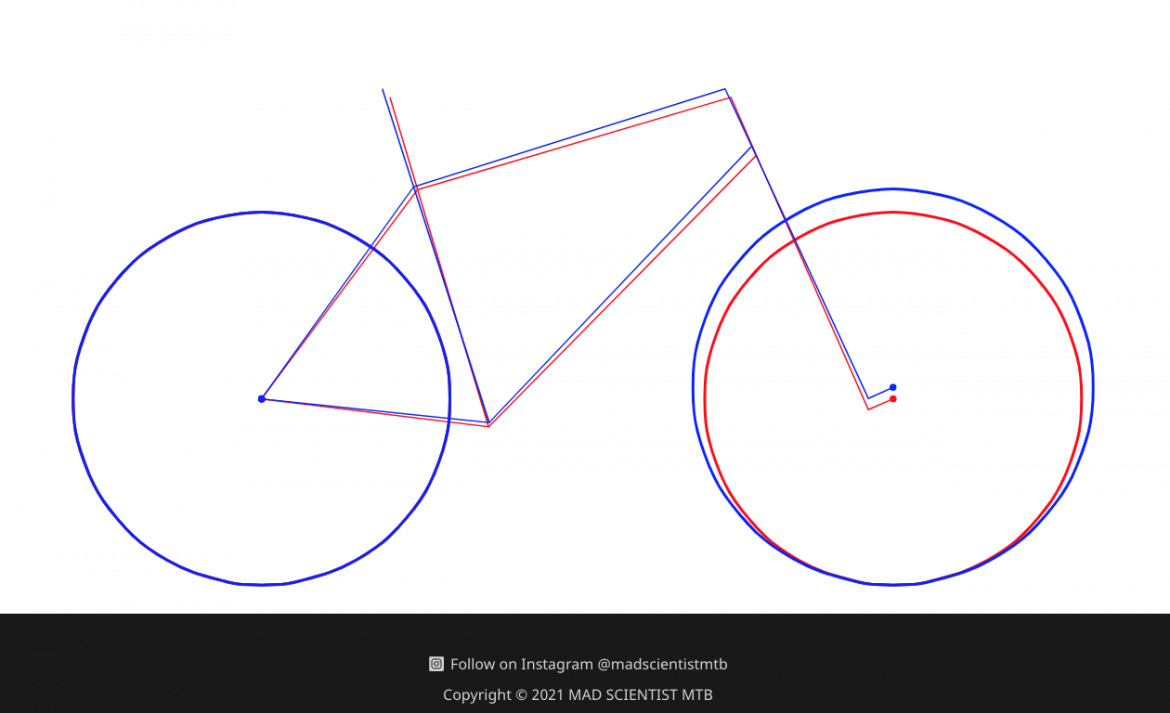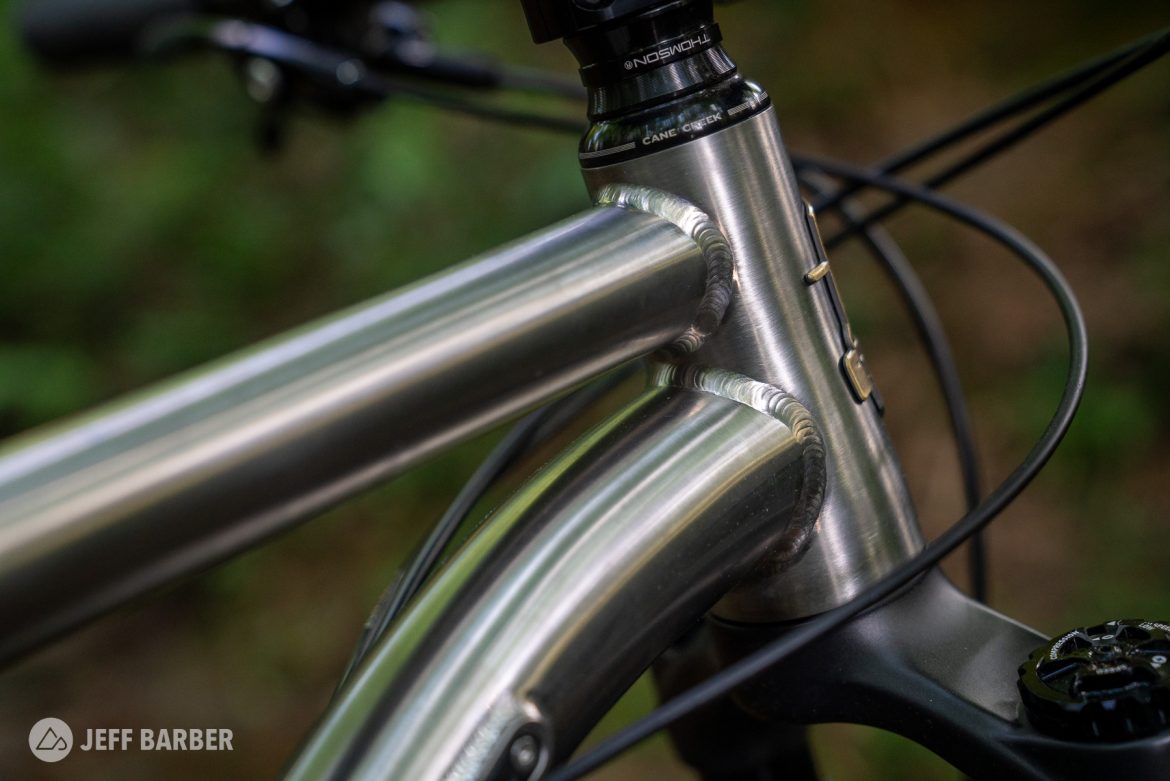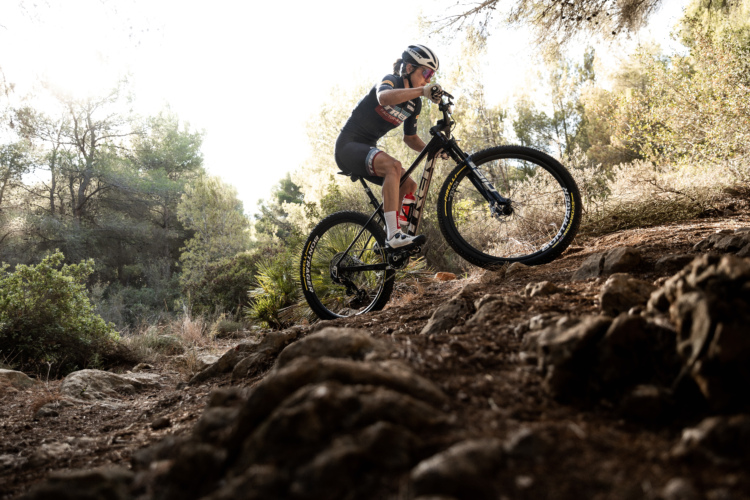
I know what you’re thinking. Thomson, the middle-Georgia based component brand, named their new ‘Hooch’ hardtail after moonshine. Or maybe you’re thinking the name is related to the Chattahoochee River, made famous by Mr. Alan Jackson, though it ain’t that either. The Hooch actually pays homage to the Chattahoochee National Forest in the north Georgia mountains, which is home to some of the best mountain bike trails on the East Coast.
I’ve been riding the Thomson Hooch titanium hardtail locally, and also in the Chattahoochee National Forest, for several weeks now. Unfortunately, the size large just isn’t large enough for me, so I’m unable to give it a full and proper review. Thomson says they’re hoping to have XL frames the next go around, but for now, the large is the biggest they’ve got. However, I have learned a good bit about the bike which I’ll share in the non-review below.
About that wheel size…
A lot of folks were surprised to see Thomson release a 27.5″ hardtail in 2021, though the brand certainly isn’t the only one with a hardcore tweener. While a few brands use 27.5″ wheels on their smaller builds, and offer 29er wheels on the larger ones, Thomson designed the Hooch frames around a 27.5″ rear for all sizes. However, many medium-to-tall riders, myself included, are used to and prefer the bigger wheel size.

I spoke with Mike Christensen from Thomson and he suggested a compromise: keep the 27.5″ wheel in the back and run a 29er up front. Since Thomson sells the Hooch as a build kit, rather than a complete bike, buyers are free to choose whatever wheel and fork combo they like, and early feedback suggests riders like a bigger wheel under the helm.
My test bike was initially set up with 27.5″ wheels front and rear, and I rode it that way for several weeks to get a good feel for it before switching to a 29er fork and wheel. I used a Cane Creek Helm Air fork for both setups, with a 2.4″ tire on the 27.5″ fork, and a 2.6″ tire on the 29er fork. The swap made a big difference in terms of the ride feel, amping up the aggressiveness noticeably, though unfortunately doing little to make the bike a better fit for my height.
What about the geometry?
Cearly, adding a 29er fork to this 27.5″ bike is going to change the geometry, which affects both the ride feel and the fit. Check out the diagram below to get an idea of how a larger wheel up front affects this bike’s geometry.

According to my measurements and online calculations, the head tube angle on the mulleted Thomson Hooch gets a full degree slacker at 65.4°. Without the 29er fork, the Hooch’s head tube angle stands out as one of the steepest among the dozen or so 140mm hardtails I looked at, so this certainly improves its descending capabilities. I definitely found the 29er wheel up front does a better job smoothing the trail.
The 29er fork also slackens the seat tube by a degree, to 72.4°. This too is an outlier among hardcore hardtails with a similar amount of fork travel, though it seems like a good tradeoff based on my tests. I wasn’t surprised to find the Hooch is an excellent climber in its default configuration; it is a lightweight hardtail after all. With matched 27.5″ wheels the bike climbs great, and with mixed wheels it climbs just as well, if not better. For particularly technical climbs, that 29er wheel up front just seems to roll over roots more easily and keeps rolling on its improved momentum.
With a larger wheel up front, the bottom bracket height is raised slightly for better log clearance in the forest, while the minor decrease in stability hasn’t been noticeable. The shorter reach however, isn’t ideal, especially since the bike wasn’t large enough for me to begin with.
The rear end of the Thomson Hooch feels particularly stiff on fast, rocky and rooty descents. My test build, with Nox wheels, includes a Cush Core insert in the rear, perhaps to allow lower pressures to soften the rear chatter, either from the frame or the wheel. (Or maybe it’s just to protect the expensive carbon rims; either way, running a lower rear tire pressure takes some of the sting out.) Pedaling on the flats and cranking up steep climbs, that stiff rear end pays off with plenty of responsiveness and efficiency.
A fairly short seat mast and a straight seat tube should allow for decently long travel dropper posts. On the large frame, there is just one set of mounts for a bottle cage located low toward the bottom bracket. It would be nice to see the mounts moved up a touch to accommodate a second set on the seat tube, at least on the size large frames.

Components
The Hooch is meant to serve as a showcase for Thomson bars, stems, and seatposts, and buyers can choose from various options for their build kit. Mine came with the Thomson TR 35C handlebars and a 35mm x 50mm stem. The handlebars strike a nice balance between providing stiffness and vibration damping, and overall they deliver a pleasant ride feel.

Naturally, all of the mountain bike builds feature a Thomson Covert Black dropper post. I tested the 150mm-travel post, which is the longest Thomson currently offers (they say a 175mm version is coming). Overall the post performs reliably. Thomson has set the return speed of the post at 0.3 meters per second which appears to be on the slower side compared to others I’ve tested. Of course, the upshot, as Thomson notes, is it is “gentle on your seating area.” I have noticed some side-to-side play in the saddle, and the remote can feel vague depending on the angle of your thumb. Thomson says to avoid lifting or hanging the bike by the dropper post stanchion which can damage the internals.
Overall
The Thomson Hooch is a beautiful looking bike, and the mixed wheels take it over the top to make it an undeniable conversation starter. Offered as a frame kit, it is essentially a blank slate for creating custom builds to suit multiple tastes, and given its high-quality construction, it’s a frame that should be around for a long time.
About the Thomson Hooch

Back in April 2021, Thomson announced the release of a new hardtail mountain bike called The Hooch. The component brand, known primarily for high-end bike parts, is offering Hooch build kits featuring a Thomson-branded stem, handlebar, seat post, and seat collar. Buyers will need to source the rest of the pieces, including a drivetrain, fork, and wheels for a complete bike. I recently received a Hooch built up for testing, and here’s a preview of the ride.


First a bit of background about the Thomson brand. The company got its start in 1981, though bike parts would come more than a decade later, in 1996. The head badge pictured above showing an airplane flying above the clouds gives a hint to the brand’s origins. According to Bike Thomson’s parent company website, “Since 1981, L.H. Thomson has been a leader in creating aerospace parts and assemblies through CNC precision manufacturing. By focusing on superior quality and innovative manufacturing and engineering, Thomson has established a reputation for making complex parts to the highest standards and specifications set forth by some of the largest companies in the world.”
The frame
The Hooch is built using “3al 2.5v aircraft grade titanium” tubing. While the company’s main operations are centered in Macon, Georgia, about an hour south of Atlanta, the Hooch frame is handmade in Taiwan where the brand’s titanium posts and handlebars are manufactured as well.

The frame features internal cable inlets on either side of the down tube, and each inlet can accept either one or two cables or hoses. The dropper remote cable briefly exits the down tube to jump over to the seat tube, while the rear brake hose and derailleur cable exit on the underside of the down tube. Mounts for a single bottle cage are included inside the front triangle.

Thomson says the frame is designed to accept 27.5-inch tires up to 2.4″ wide. My test bike appears to offer plenty of clearance with 2.4s, and depending on the rider’s risk tolerance, a slightly wider tire will probably work fine too. A 140mm fork puts this bike in its sweet spot in terms of geometry and ride feel, though there is likely some wiggle room with the travel up front.
Depending on the wheels, drivetrain, fork, and other parts selected, complete build weights for the Hooch will vary widely. As a point of reference, this particular build weighs 29.3lbs with pedals and a bottle cage.
Geometry
The bike I’m testing is a size large. A 66.5° head tube angle leans the bike toward the hardcore hardtail camp, though the 455mm reach (size large) is fairly short by most standards. The 27.5-inch wheels and 430mm chain stays promise a playful trail character while the 73.5° seat tube angle should make climbs quite tolerable.
| S | M | L | |
| REACH | 404mm | 423mm | 455mm |
| TOP TUBE LENGTH | 590 | 609mm | 640mm |
| STACK | 626mm | 626mm | 626mm |
| WHEELBASE | 1130mm | 1149mm | 1186mm |
| CHAINSTAY LENGTH | 430mm | 430mm | 430mm |
| FRONT CENTER | 710mm | 730mm | 761mm |
| BB DROP | 53mm | 53mm | 53mm |
| SEAT TUBE ANGLE | 73.5° | 73.5° | 73.5° |
| HEAD TUBE ANGLE | 66.5° | 66.5° | 66.5° |
| SEAT TUBE LENGTH | 410mm | 440mm | 470 |
| HEAD TUBE LENGTH | 100mm | 100mm | 100mm |
| FORK RAKE | 51mm | 51mm | 51mm |
| FORK ATC | 546mm | 546mm | 546mm |

The build
I’m going to try my best to avoid talking about the components on this test bike that are NOT part of the build that’s available for purchase from Thomson. Basically, all the parts supplied with the build kit can all be classified as cockpit bits and a dropper.
Starting at the bars, this build features Thomson TR 35C carbon handlebars. Buyers can choose from aluminum, carbon, or titanium bars and obviously there are different costs depending on the selection. The bars I’m testing are 800mm wide with a 10mm rise (the 35mm-diameter carbon bars are also available with a 20mm rise). A 35mm-diameter, 50mm-long Elite X4 stem grips the bars; 32mm and 40mm stem lengths are also available.
While Thomson does make fixed posts for mountain biking, naturally all of the Hooch mountain bike builds come with a Thomson Covert dropper post. My size large test bike has a post with 150mm of travel, and 100mm and 125mm versions can also be selected. There’s even a Thomson seat collar included, along with Thomson headset spacers in silver or black.


One non-Thomson piece of the puzzle that bears mentioning on this test bike is the custom wheel set built up with Nox carbon rims and Factor hubs. The rims are 26mm wide and the rear hub provides 5° of engagement. Again, this is not something Thomson includes with the build kit; buyers will need to supply their own wheels.
Frame kits including a stem, bar, and dropper post are priced starting at $3,295 and are available through the Thomson website.






















1 Comments
Jul 9, 2021